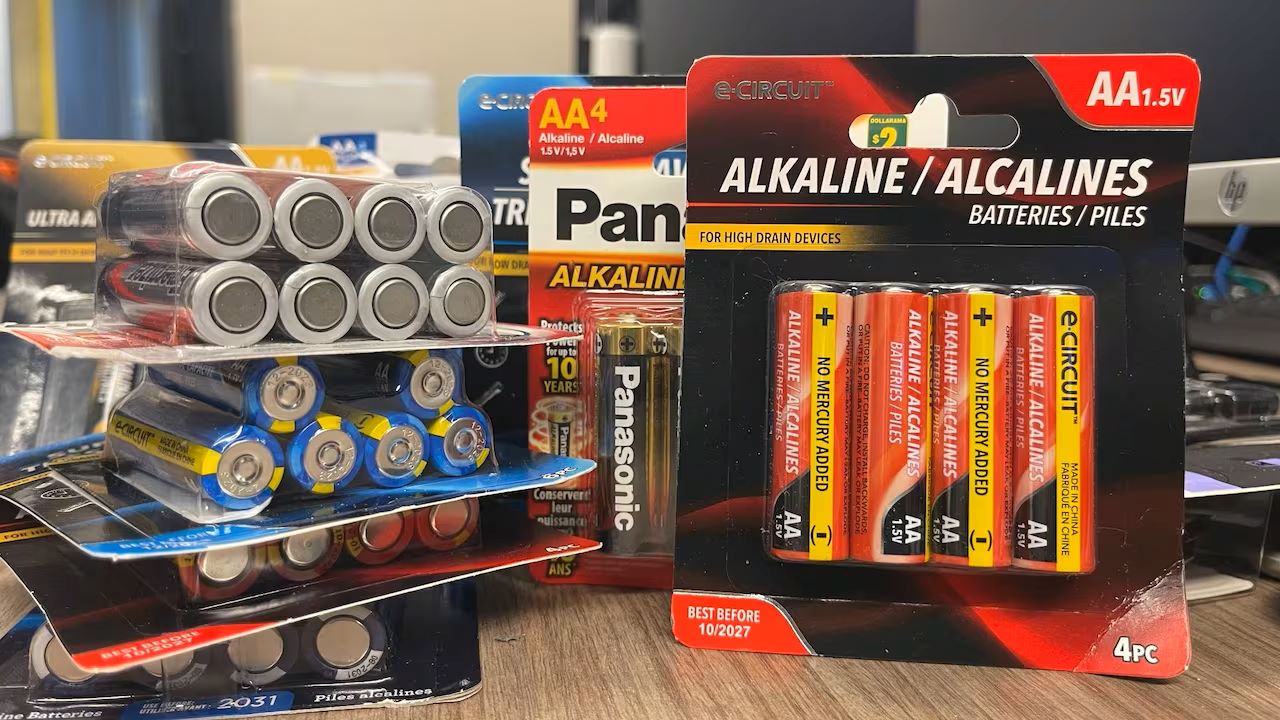

Articles
How To Store Batteries Long Term
Modified: January 6, 2024
Discover effective methods to store batteries long term in this helpful article, packed with practical advice and expert tips.
(Many of the links in this article redirect to a specific reviewed product. Your purchase of these products through affiliate links helps to generate commission for Storables.com, at no extra cost. Learn more)
Introduction
Storing batteries long term is a crucial aspect of maintaining their performance and longevity. Whether it’s for emergency backups, seasonal use of devices, or simply keeping spare batteries for future needs, proper storage practices can make a significant difference in preserving battery life and optimizing their functionality.
In this article, we will explore the importance of storing batteries long term and provide valuable insights on how to achieve it effectively. We will delve into the factors to consider when storing batteries, the selection of an appropriate storage location, the preparation process, the different methods of storage, tips for maximizing battery lifespan, and common misconceptions about battery storage.
By following the recommendations outlined in this article, you will not only save money on frequently purchasing new batteries but also ensure that your stored batteries are ready for use when you need them the most. So let’s dive in and explore the world of long-term battery storage!
Key Takeaways:
- Proper long-term battery storage is crucial for maintaining performance, saving money, and being prepared for emergencies. Consider factors like temperature, humidity, and ventilation for optimal storage conditions.
- Avoid common misconceptions about battery storage, such as refrigerating or freezing batteries, reviving fully discharged batteries, and leaving batteries constantly connected to chargers. Follow proper storage practices to ensure reliable power and prolonged battery life.
Read more: How To Store A Battery Long Term
Why is it important to store batteries long term?
Properly storing batteries long term is essential for several reasons. First and foremost, it helps to maintain their overall performance and extend their lifespan. When batteries are left unused for an extended period, they can suffer from self-discharge, which gradually drains their energy. By employing effective storage techniques, you can minimize self-discharge and ensure that your batteries retain their power for extended periods.
Additionally, long-term battery storage is crucial for emergency preparedness. In times of power outages or natural disasters, having a reliable source of backup power is essential. By storing batteries properly, you can be confident that they will be fully charged and ready to use when you need them most.
Moreover, proper battery storage helps to prevent leakage and corrosion. Batteries contain chemicals that can be harmful if they come into contact with skin or other materials. Storing batteries in suitable locations and conditions can prevent leakage, which can cause damage to surrounding objects and pose risks to your personal safety.
Furthermore, storing batteries long term can save you money in the long run. When batteries are stored correctly, their lifespan can be significantly extended, reducing the need for frequent replacements. This not only saves you the cost of purchasing new batteries but also reduces environmental waste, contributing to a more sustainable future.
By understanding the importance of storing batteries long term, you can ensure that they remain in optimal condition, ready for use whenever you need them. Let’s explore the factors to consider when storing batteries to maximize their longevity.
Factors to consider when storing batteries
When it comes to storing batteries long term, there are several factors you should keep in mind to ensure optimal storage conditions. Let’s take a closer look at these factors:
- Temperature: Batteries should be stored in a cool, dry place. High temperatures can accelerate self-discharge and shorten battery life, while extreme cold temperatures can impair their performance. Aim for a storage temperature between 50°F (10°C) and 77°F (25°C) for best results.
- Humidity: Excessive humidity can lead to corrosion and leakage in batteries. It’s important to store batteries in a dry environment to prevent any moisture-related damage. Consider using airtight containers or zip-lock bags to create a barrier against moisture.
- Light: Exposure to direct sunlight or strong artificial light can have a negative impact on battery performance and longevity. It’s best to store batteries in a dark place to minimize light exposure.
- Ventilation: While it’s important to store batteries in a closed container to protect them, proper ventilation is also necessary. Ventilation helps to prevent the buildup of gases that can be released during the chemical reactions within batteries. Avoid sealing batteries in airtight containers for long periods.
- Separation: When storing different types of batteries, it’s crucial to keep them separate. Mixing batteries of different chemistries or different states of charge can lead to leakage, explosion, or other safety hazards. To avoid this, use separate containers or dividers for each type of battery.
- Labeling: It’s a good practice to label your stored batteries with the date of storage. This way, you can keep track of their age and prioritize using the oldest batteries first. It helps to rotate your battery stock regularly to ensure that none of them are forgotten about or left unused for too long.
By considering these factors and implementing appropriate storage practices, you can significantly improve the longevity and performance of your batteries. Now that we’ve explored the factors to consider, let’s delve into choosing the right storage location for your batteries.
Choosing the right storage location
Selecting the proper storage location for your batteries is vital to ensure their long-term performance and safety. Here are some key considerations when choosing a suitable storage area:
- Cool and dry: Look for a storage space that is cool and dry, as high temperatures and humidity can accelerate battery degradation. Avoid areas near direct sunlight or sources of heat, such as radiators or electrical appliances.
- Well-ventilated: Good airflow is crucial to prevent the buildup of gases that can be released by batteries during self-discharge. Choose a storage location that is well-ventilated to minimize the risk of gas accumulation.
- Stable temperature: Fluctuations in temperature can negatively impact battery performance. Aim for a storage area with a stable temperature, avoiding areas subject to extreme temperature changes, like attics or garages.
- Away from moisture: Moisture can lead to corrosion and leakage in batteries. Keep your storage location away from areas prone to dampness, such as basements or bathrooms. If you live in a particularly humid environment, consider using moisture-absorbing products like silica gel packets.
- Out of reach: If you have young children or pets in the house, it’s crucial to store your batteries in a location that is inaccessible to them. Batteries can pose a choking hazard if accidentally ingested, and some types of batteries can be potentially harmful if mishandled.
- Organized and labeled: Keeping your storage area organized and labeling the containers can help you locate specific batteries easily and track their storage dates. Consider using storage organizers or clear containers to store and categorize your batteries efficiently.
By taking the time to choose an appropriate storage location, you can ensure that your batteries remain in optimal condition, maximizing their lifespan and usability. Now that you have selected the perfect storage location, let’s move on to the next step: preparing batteries for long-term storage.
Preparing batteries for long-term storage
Before you store batteries for an extended period, it’s important to take some preparatory steps to ensure they remain in optimal condition. Here are some essential tips for preparing batteries for long-term storage:
- Clean the batteries: Before storing your batteries, make sure to clean them with a soft, dry cloth. This helps remove any dirt, debris, or residue that may have accumulated on the battery surface.
- Check battery charge: It’s a good idea to check the charge level of your batteries before storing them. Ideally, store batteries with a partial charge rather than a full charge. Fully charging batteries and leaving them idle for long periods can lead to self-discharge and reduce their overall performance.
- Remove batteries from devices: If you plan to store batteries that are currently in devices, it’s recommended to remove them. Leaving batteries inside devices can lead to energy drain and potential damage to both the batteries and the devices themselves.
- Inspect for damage: Before storing batteries, inspect them for any signs of damage, such as leakage or corrosion. If you come across any damaged batteries, dispose of them properly rather than storing them.
- Use appropriate packaging: To ensure maximum protection, consider using individual battery cases, small zip-lock bags, or dedicated battery organizers to store batteries. This prevents contact between different battery types and reduces the risk of accidental short circuits.
- Avoid extreme temperatures: When preparing batteries for storage, it’s essential to keep them away from extreme temperature conditions. Extreme heat or intense cold can have a detrimental impact on battery performance and longevity.
- Keep batteries separate: If you are storing multiple batteries, it’s important to keep them separate. Different battery chemistries and varying charge levels can lead to adverse reactions, leakage, or potential hazards.
- Label and date: Labeling each container or organizing system with the type of batteries and the date of storage can help ensure that you rotate your battery stock properly. This practice ensures that older batteries are used first to prevent them from deteriorating further over time.
By following these preparation steps, you can ensure that your batteries are well-maintained and ready for long-term storage. Now that you have prepared your batteries, it’s time to explore different methods of storing them effectively.
Store batteries in a cool, dry place at room temperature. Avoid extreme heat or cold, as it can reduce their performance and lifespan. Keep them in their original packaging or in a battery organizer to prevent contact with metal objects.
Read more: How To Store A Car Battery Long Term
Different methods of storing batteries
There are several methods you can employ to store batteries effectively and ensure their longevity. Let’s explore some of the common and effective methods:
- Battery cases: Battery cases are specially designed containers that provide individual compartments for each battery. These cases protect the batteries from physical damage, accidental short circuits, and contact with other batteries. They are available in various sizes and can be easily labeled for organization.
- Zip-lock bags: Using small, resealable zip-lock bags is a simple and cost-effective way to store batteries. Place each battery in its own bag to prevent contact between different battery types. You can also add a small packet of silica gel to absorb any excess moisture.
- Battery organizers: Battery organizers are often made of durable materials and feature designated slots or compartments to store batteries securely. They come in different shapes and sizes, offering convenience and easy access to your battery collection.
- Original packaging: If you have kept the original packaging of your batteries, it can be an effective storage option. Most battery packaging provides proper insulation and protection for the batteries. Place the batteries back into their original packaging and store them in a dry location.
- Battery drawers or cabinets: If you have a large battery collection, investing in a dedicated battery drawer or cabinet can help you keep them organized and easily accessible. These storage units typically feature compartments or adjustable dividers to keep batteries separated.
- Battery racks or holders: Battery racks or holders are designed to keep batteries in an upright position, minimizing the risk of accidental damage or contact. They come in various sizes and can be mounted on walls or stored in drawers or cabinets.
When selecting a storage method, consider factors such as the number of batteries you need to store, the available space, and the level of organization you prefer. Whichever method you choose, ensure that it provides adequate protection, prevents contact between different battery types, and allows for easy access and rotation of your battery stock.
Now that you are familiar with different methods of storing batteries, let’s move on to some tips for maximizing battery lifespan during storage.
Tips for maximizing battery lifespan during storage
To ensure that your batteries maintain their performance and longevity while in storage, consider following these tips:
- Regularly inspect stored batteries: Periodically check the condition of your stored batteries for any signs of leakage, corrosion, or damage. If you notice any issues, handle and dispose of them properly to prevent any further contamination.
- Rotate your battery stock: To prevent any batteries from being left unused for too long, it’s important to rotate your battery stock regularly. Use the oldest batteries first and replace them with fresh ones. This practice ensures that all batteries are used and reduces the risk of deterioration over time.
- Charge rechargeable batteries periodically: If you are storing rechargeable batteries, it’s recommended to give them a partial recharge every three to six months. This helps to maintain their charge and prevent capacity loss during storage.
- Keep batteries at a moderate temperature: Extreme temperatures can have a negative impact on battery life. Avoid exposing stored batteries to high heat or extreme cold. Optimal storage temperature ranges from 50°F (10°C) to 77°F (25°C) to ensure their longevity.
- Check battery voltage: If you have the means to do so, periodically check the voltage of stored batteries using a multimeter. This can give you an indication of their health and whether they may need to be recharged or replaced.
- Avoid storing batteries in electronics: While it may be tempting to store batteries inside devices, it’s best to remove them. Leaving batteries in electronics for extended periods can lead to energy drain and potential damage to both the batteries and the devices.
- Prevent contact between battery terminals: When storing batteries, ensure that the terminals do not come into contact with each other. If the terminals touch, they can create a short circuit and potentially damage the batteries.
- Use a battery tester: Consider using a battery tester to assess the remaining capacity of stored batteries. This can help you determine whether a battery is still suitable for use or if it needs to be replaced.
By following these tips, you can maximize the lifespan and performance of your stored batteries. Remember, proper storage and maintenance can significantly extend the life of your batteries, ensuring that they are reliable when you need them. Now, let’s address some common misconceptions about battery storage.
Common misconceptions about battery storage
There are several misconceptions surrounding battery storage that can lead to poor practices and potential damage. Let’s debunk some of the common misconceptions:
- Storing batteries in the refrigerator: While refrigeration may seem like a good idea to prolong battery life, it’s not necessary and can actually be harmful. The moisture and condensation in a refrigerator can damage the batteries, leading to leakage and reduced performance.
- Freezing batteries to extend their lifespan: Freezing batteries is unnecessary and can cause more harm than good. Extreme cold temperatures can cause the battery casings to crack or rupture, rendering the batteries useless.
- Reviving fully discharged batteries: It’s commonly believed that fully discharged batteries can be revived by storing them for an extended period. In reality, fully discharged batteries may undergo irreversible chemical reactions that can reduce their capacity or render them completely unusable.
- Using heat to revive depleted batteries: Some people believe that exposing depleted batteries to heat, such as placing them on a warm surface or using a hairdryer, can restore their capacity. However, applying heat can be dangerous, as it may cause the battery to leak, explode, or catch fire.
- Leaving batteries on a charger indefinitely: It’s a misconception that keeping batteries constantly connected to a charger will keep them in optimal condition. Overcharging batteries can lead to overheating, reduced performance, and a shorter overall lifespan. It’s best to disconnect the batteries once they are fully charged.
- Storing batteries loose in a drawer: Storing loose batteries in a drawer without any protection can lead to accidental contact between terminals, potentially causing a short circuit. It’s important to keep batteries separate and stored in appropriate containers to prevent this risk.
- All batteries have the same storage requirements: Different battery chemistries, such as alkaline, lithium-ion, or lead-acid, have different storage requirements. It’s important to familiarize yourself with the specific recommendations for each type of battery to optimize their storage conditions.
By debunking these misconceptions, you can ensure that you are following proper battery storage practices and protecting your batteries from potential damage. Now let’s conclude our discussion on storing batteries long term.
Conclusion
Properly storing batteries long term is essential for maintaining their performance, extending their lifespan, and ensuring they are ready for use when needed. By considering factors such as temperature, humidity, ventilation, and separation, you can create an optimal storage environment for your batteries.
Choosing the right storage location, such as a cool, dry, and well-ventilated area, is crucial to prevent self-discharge, leakage, and corrosion. Taking the time to prepare your batteries for storage by cleaning them, checking their charge level, and removing them from devices can help preserve their condition.
There are various methods you can employ to store your batteries effectively, such as battery cases, zip-lock bags, organizers, or original packaging. Select a method that suits your needs and ensures individual battery protection and organization.
To maximize battery lifespan during storage, it’s important to regularly inspect the batteries, rotate your stock, charge rechargeable batteries periodically, and keep them at a moderate temperature. Avoid common misconceptions about battery storage, such as refrigerating or freezing batteries, reviving fully discharged batteries, or leaving batteries constantly connected to chargers.
By following these guidelines and debunking misconceptions, you can ensure that your stored batteries remain in optimal condition, ready for use whenever you need them. Proper battery storage not only helps you save money but also reduces environmental waste, contributing to a more sustainable future.
So, take the necessary steps to store your batteries correctly and enjoy the benefits of reliable power and prolonged battery life. With the right storage practices, your batteries will be reliable sources of energy for all your devices and emergency needs.
Frequently Asked Questions about How To Store Batteries Long Term
Was this page helpful?
At Storables.com, we guarantee accurate and reliable information. Our content, validated by Expert Board Contributors, is crafted following stringent Editorial Policies. We're committed to providing you with well-researched, expert-backed insights for all your informational needs.















0 thoughts on “How To Store Batteries Long Term”